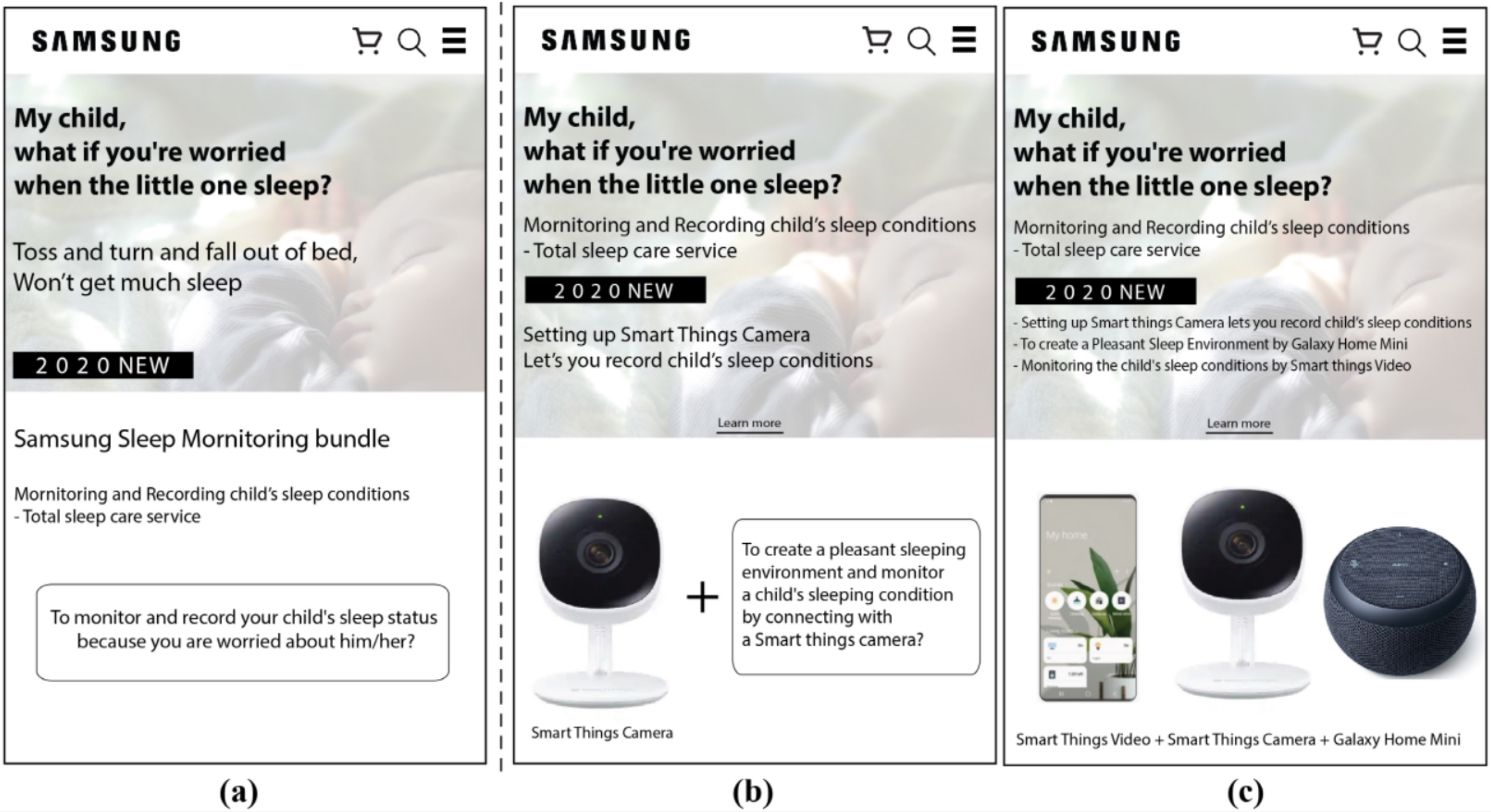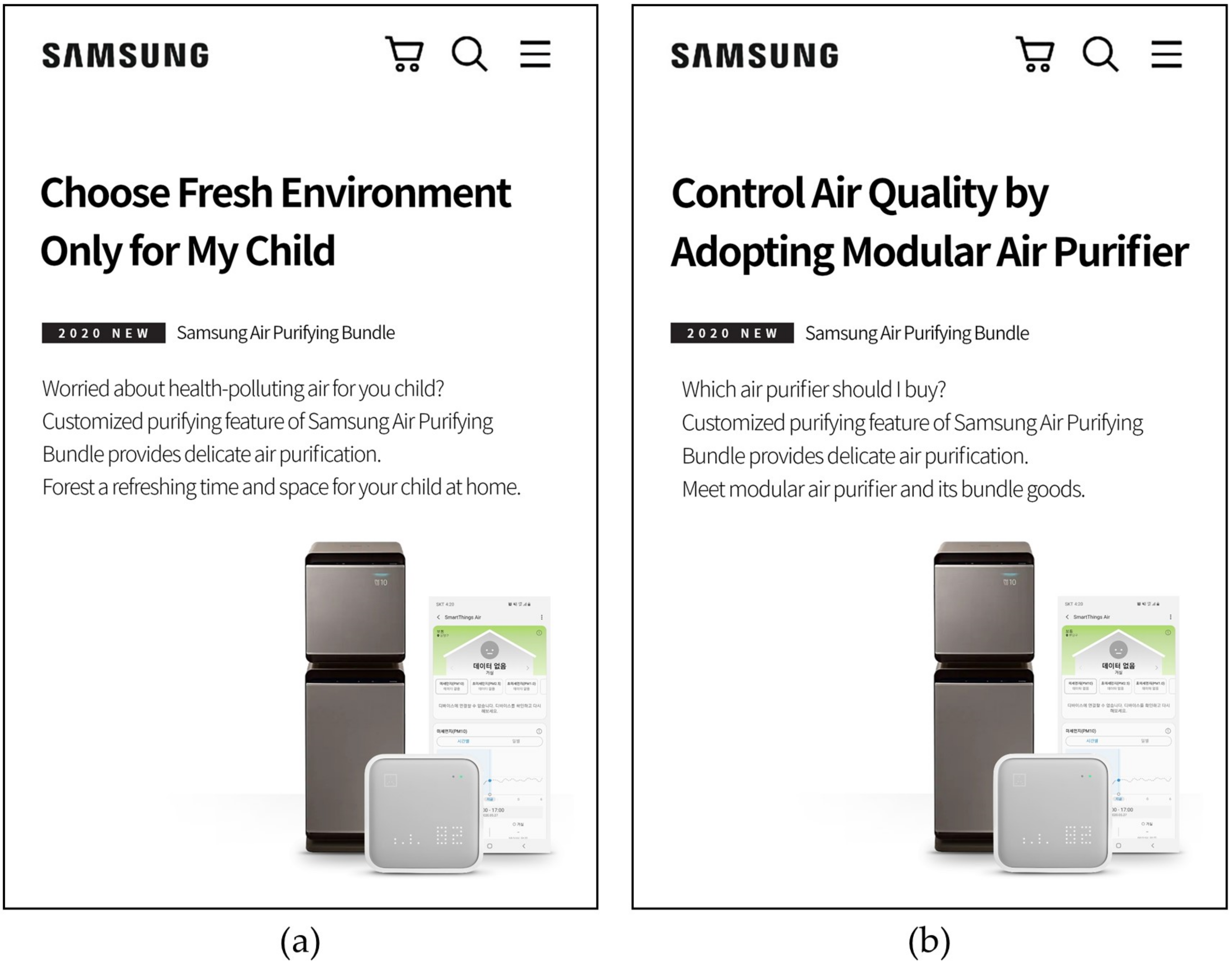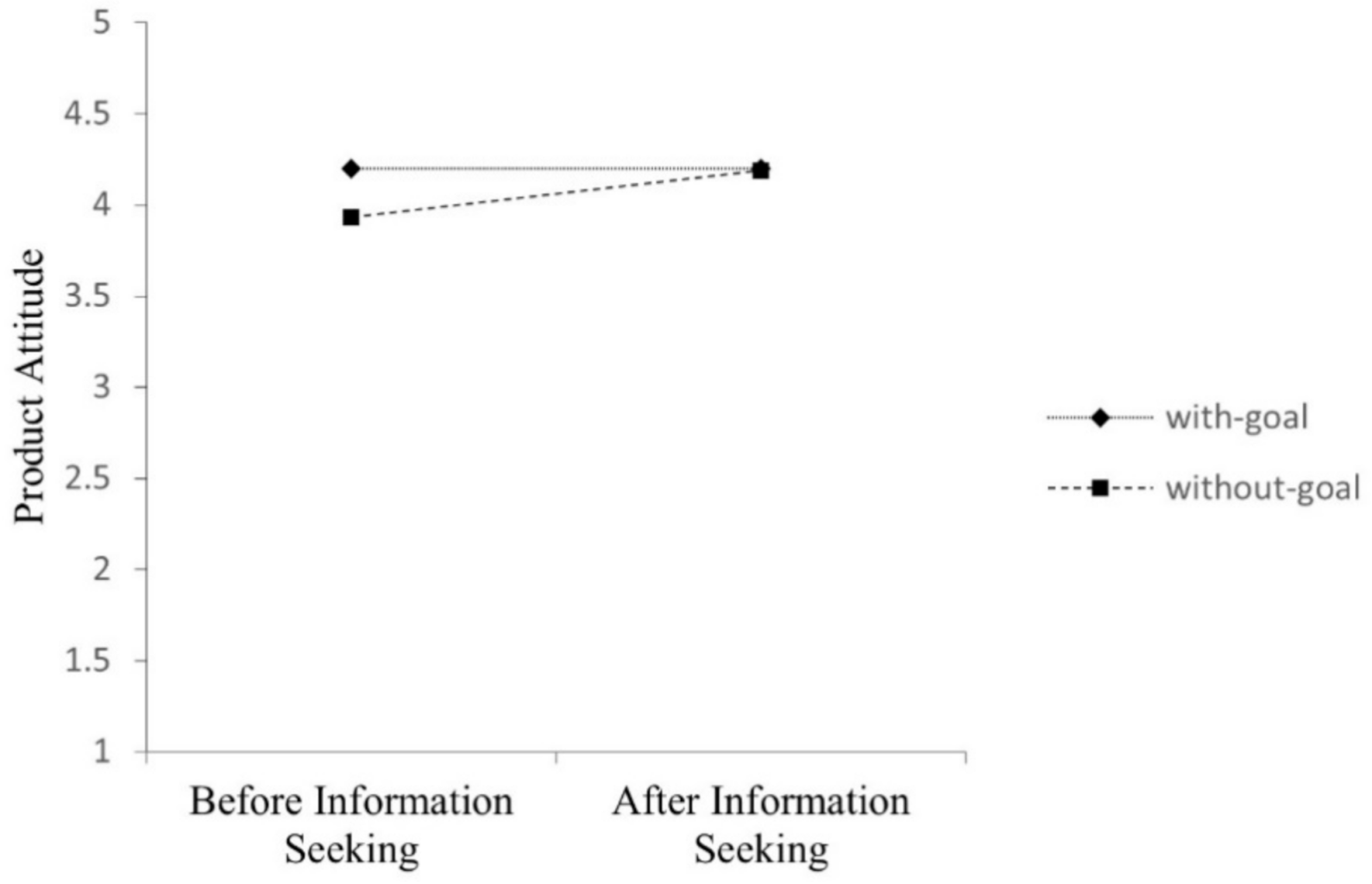Rethinking a Designers’ Rule of Thumb: Influence of Information Seeking and Consumption Goals on Mobile Commerce Interface Design
Abstract
1. Introduction
2. Literature Review
2.1. The Benefits of Uncertainty About Hybrid Products (HPs)
2.2. Information Seeking
2.3. Consumption Goals
3. Studies
3.1. Study Overview
3.2. Study 1
3.2.1. Experimental Design
3.2.2. Methodology
3.2.3. Results and Discussion
3.3. Study 2
3.3.1. Experimental Design
3.3.2. Methodology
3.3.3. Results and Discussion
4. Conclusions
4.1. Summary of Findings
4.2. Academic Contributions
4.3. Managerial Implications
5. Limitations and Future Research
Author Contributions
Funding
Institutional Review Board Statement
Informed Consent Statement
Data Availability Statement
Acknowledgments
Conflicts of Interest
References
- Chong, A.Y.-L. Mobile Commerce Usage Activities: The Roles of Demographic and Motivation Variables. Technol. Forecast. Soc. Chang. 2013, 80, 1350–1359. [Google Scholar] [CrossRef]
- 2018 Global M-Commerce Report. Available online: www.researchandmarkets.com (accessed on 2 December 2020).
- Ngai, E.W.T.; Gunasekaran, A. A Review for Mobile Commerce Research and Applications. Decis. Support Syst. 2007, 43, 3–15. [Google Scholar] [CrossRef]
- Ahmad, Z.; Ibrahim, R. Mobile Commerce (M-Commerce) Interface Design: A Review of Literature. OSR J. Comput. Eng. 2017, 19, 66–70. [Google Scholar] [CrossRef]
- Wu, Y.-L.; Ye, Y.-S. Understanding Impulsive Buying Behavior in Mobile Commerce. In PACIS; 2013; p. 142. Available online: http://aisel.aisnet.org/pacis2013/142 (accessed on 18 December 2020).
- Lee, Y.E.; Benbasat, I. Interface Design for Mobile Commerce. Commun. ACM 2003, 46, 48–52. [Google Scholar] [CrossRef]
- Buyukkokten, O.; Kaljuvee, O.; Garcia-Molina, H.; Paepcke, A.; Winograd, T. Efficient Web Browsing on Handheld Devices Using Page and Form Summarization. ACM Trans. Inf. Syst. 2002, 20, 82–115. [Google Scholar] [CrossRef]
- Kim, H.; Kim, J.; Lee, Y. An Empirical Study of Use Contexts in the Mobile Internet, Focusing on the Usability of Information Architecture. Inf. Syst. Front. 2005, 7, 175–186. [Google Scholar] [CrossRef]
- Jung, W. The Effect of Representational UI Design Quality of Mobile Shopping Applications on Users’ Intention to Shop. Procedia Comput. Sci. 2017, 121, 166–169. [Google Scholar] [CrossRef]
- Wolfinbarger, M.; Gilly, M.C. Shopping Online for Freedom, Control, and Fun. Calif. Manag. Rev. 2001, 43, 34–55. [Google Scholar] [CrossRef]
- Porter, J. Testing the Three-Click Rule. User Interface Eng. 2003. Available online: www.uie.com/articles/three_click_rule (accessed on 27 December 2020).
- Krug, S. The Do-It-Yourself Guide to Finding and Fixing Usability Problems; New Riders: Indianapolis, IN, USA, 2009; pp. 102–128. ISBN 978-0321657299. [Google Scholar]
- Agarwal, A.; Meyer, A. Beyond Usability: Evaluating Emotional Response as an Integral Part of the User Experience. In CHI’09 Extended Abstracts on Human Factors in Computing Systems; Association for Computing Machinery: Boston, MA, USA, 2009; pp. 2919–2930. [Google Scholar] [CrossRef]
- Chen, J.; Teng, L.; Yu, Y.; Yu, X. The Effect of Online Information Sources on Purchase Intentions between Consumers with High and Low Susceptibility to Informational Influence. J. Bus. Res. 2016, 69, 467–475. [Google Scholar] [CrossRef]
- Chiu, C.; Wang, E.T.G.; Fang, Y.; Huang, H. Understanding Customers’ Repeat Purchase Intentions in B2C E-commerce: The Roles of Utilitarian Value, Hedonic Value and Perceived Risk. Inf. Syst. J. 2014, 24, 85–114. [Google Scholar] [CrossRef]
- Kim, M.; Lennon, S.J. Television Shopping for Apparel in the United States: Effects of Perceived Amount of Information on Perceived Risks and Purchase Intentions. Fam. Consum. Sci. Res. J. 2000, 28, 301–331. [Google Scholar] [CrossRef]
- Novak, T.P.; Hoffman, D.L.; Duhachek, A. The Influence of Goal-directed and Experiential Activities on Online Flow Experiences. J. Consum. Psychol. 2003, 13, 3–16. [Google Scholar] [CrossRef]
- Gibbert, M.; Mazursky, D. How Successful Would a Phone-Pillow Be: Using Dual Process Theory to Predict the Success of Hybrids Involving Dissimilar Products. J. Consum. Psychol. 2009, 19, 652–660. [Google Scholar] [CrossRef]
- Alexander, N. Defining Brand Values through Sponsorship. Int. J. Retail Distrib. Manag. 2009, 37, 346–357. [Google Scholar] [CrossRef]
- Nguyen, T.; Joo, J. Digital Strikes Back: Reading Digital Clocks Decreases New Product Adoption. Arch. Des. Res. 2019, 32, 103–114. [Google Scholar] [CrossRef]
- Zhao, M.; Hoeffler, S.; Dahl, D.W. Imagination Difficulty and New Product Evaluation. J. Prod. Innov. Manag. 2012, 29, 76–90. [Google Scholar] [CrossRef]
- Ma, Z.; Yang, Z.; Mourali, M. Consumer Adoption of New Products: Independent versus Interdependent Self-Perspectives. J. Mark. 2014, 78, 101–117. [Google Scholar] [CrossRef]
- Gourville, J.T. Eager Sellers and Stony Buyers: Understanding the Psychology of New-Product Adoption. Harv. Bus. Rev. 2006, 84, 98–106. [Google Scholar]
- Hoeffler, S. Measuring Preferences for Really New Products. J. Mark. Res. 2003, 40, 406–420. [Google Scholar] [CrossRef]
- Herzenstein, M.; Posavac, S.S.; Brakus, J.J. Adoption of New and Really New Products: The Effects of Self-Regulation Systems and Risk Salience. J. Mark. Res. 2007, 44, 251–260. [Google Scholar] [CrossRef]
- Claudy, M.C.; Garcia, R.; O’Driscoll, A. Consumer Resistance to Innovation—A Behavioral Reasoning Perspective. J. Acad. Mark. Sci. 2015, 43, 528–544. [Google Scholar] [CrossRef]
- Gill, T.; Dube, L. What Is a Leather Iron or a Bird Phone? Using Conceptual Combinations to Generate and Understand New Product Concepts. J. Consum. Psychol. 2007, 17, 202–217. [Google Scholar] [CrossRef]
- Wilkenfeld, M.J.; Ward, T.B. Similarity and Emergence in Conceptual Combination. J. Mem. Lang. 2001, 45, 21–38. [Google Scholar] [CrossRef]
- Wisniewski, E.J. Construal and Similarity in Conceptual Combination. J. Mem. Lang. 1996, 35, 434–453. [Google Scholar] [CrossRef]
- Moore, W.L.; Lehmann, D.R. Individual Differences in Search Behavior for a Nondurable. J. Consum. Res. 1980, 7, 296–307. [Google Scholar] [CrossRef]
- Reilly, M.D.; Conover, J.N. Meta-Analysis: Integrating Results from Consumer Research Studies. ACR N. Am. Adv. 1983, 10, 509–573. [Google Scholar]
- James, F.E.; Roger, D.B.; Paul, W.M. Consumer Behavior, 5th ed.; The Dryden Press: New York, NY, USA, 1986; pp. 23–39. [Google Scholar]
- Hoyer, W.D.; MacInnis, D.J.; Pieters, R. Consumer Behavior; Cengage Learning: Boston, MA, USA, 2013; pp. 184–212. [Google Scholar]
- Newman, J.W. Consumer External Search: Amount and Determinants. In Consumer and Industrial Buying Behavior; Elsevier: New York, NY, USA, 1997; pp. 79–94. ISBN 0-444-00230-8. [Google Scholar]
- Srinivasan, N. Pre-Purchase External Search for Information. Rev. Mark. 1990, 4, 153–189. [Google Scholar]
- Janiszewski, C. The Influence of Display Characteristics on Visual Exploratory Search Behavior. J. Consum. Res. 1998, 25, 290–301. [Google Scholar] [CrossRef]
- Vogt, C.A.; Fesenmaier, D.R. Expanding the Functional Information Search Model. Ann. Tour. Res. 1998, 25, 551–578. [Google Scholar] [CrossRef]
- Artandi, S. Information Concepts and Their Utility. J. Am. Soc. Inf. Sci. 1973, 24, 242–245. [Google Scholar] [CrossRef]
- Flanagin, A.J.; Metzger, M.J.; Pure, R.; Markov, A.; Hartsell, E. Mitigating Risk in Ecommerce Transactions: Perceptions of Information Credibility and the Role of User-Generated Ratings in Product Quality and Purchase Intention. Electron. Commer. Res. 2014, 14, 1–23. [Google Scholar] [CrossRef]
- Castaño, R.; Sujan, M.; Kacker, M.; Sujan, H. Managing Consumer Uncertainty in the Adoption of New Products: Temporal Distance and Mental Simulation. J. Mark. Res. 2008, 45, 320–336. [Google Scholar] [CrossRef]
- Cheung, C.M.K.; Thadani, D.R. The Impact of Electronic Word-of-Mouth Communication: A Literature Analysis and Integrative Model. Decis. Support Syst. 2012, 54, 461–470. [Google Scholar] [CrossRef]
- Van der Heijden, H.; Verhagen, T.; Creemers, M. Understanding Online Purchase Intentions: Contributions from Technology and Trust Perspectives. Eur. J. Inf. Syst. 2003, 12, 41–48. [Google Scholar] [CrossRef]
- Kuhlthau, C.C. A Principle of Uncertainty for Information Seeking. J. Doc. 1993, 49, 339–355. [Google Scholar] [CrossRef]
- Nicholas, D.; Dobrowolski, T.; Withey, R.; Russell, C.; Huntington, P.; Williams, P. Digital Information Consumers, Players and Purchasers: Information Seeking Behaviour in the New Digital Interactive Environment. Aslib Proc. 2003, 55, 22–31. [Google Scholar] [CrossRef]
- Moreau, C.P.; Markman, A.B.; Lehmann, D.R. What Is It? Categorization Flexibility and Consumers’ Responses to Really New Products. J. Consum. Res. 2001, 27, 489–498. [Google Scholar] [CrossRef]
- Jhang, J.H.; Grant, S.J.; Campbell, M.C. Get It? Got It. Good! Enhancing New Product Acceptance by Facilitating Resolution of Extreme Incongruity. J. Mark. Res. 2012, 49, 247–259. [Google Scholar] [CrossRef]
- Rogers, E.M. Diffusion of Innovations: Modifications of a Model for Telecommunications; Die Diffusion von Innovationen in der Telekommunikation; Springer: New York, NY, USA, 1995; pp. 25–38. [Google Scholar] [CrossRef]
- Barsalou, L.W. Context-Independent and Context-Dependent Information in Concepts. Mem. Cognit. 1982, 10, 82–93. [Google Scholar] [CrossRef]
- Camerer, C.; Weber, M. Recent Developments in Modeling Preferences: Uncertainty and Ambiguity. J. Risk Uncertain. 1992, 5, 325–370. [Google Scholar] [CrossRef]
- Wells, C.; van Thomme, J.; Maurer, P.; Hanna, A.; Pevehouse, J.; Shah, D.V.; Bucy, E. Coproduction or Cooptation? Real-Time Spin and Social Media Response during the 2012 French and US Presidential Debates. French Polit. 2016, 14, 206–233. [Google Scholar] [CrossRef]
- Kim, J.-H.; Kim, M.; Kandampully, J. The Impact of Buying Environment Characteristics of Retail Websites. Serv. Ind. J. 2007, 27, 865–880. [Google Scholar] [CrossRef]
- Yoo, J.; Kim, M. The Effects of Online Product Presentation on Consumer Responses: A Mental Imagery Perspective. J. Bus. Res. 2014, 67, 2464–2472. [Google Scholar] [CrossRef]
- Mikalef, P.; Sharma, K.; Pappas, I.O.; Giannakos, M.N. Online Reviews or Marketer Information? An Eye-Tracking Study on Social Commerce Consumers. In Conference on E-Business, E-Services and E-Society; Springer: New York, NY, USA, 2017; pp. 388–399. [Google Scholar] [CrossRef]
- Barsalou, L.W. Ad Hoc Categories. Mem. Cognit. 1983, 11, 211–227. [Google Scholar] [CrossRef] [PubMed]
- Ratneshwar, S.; Barsalou, L.W.; Pechmann, C.; Moore, M. Goal-Derived Categories: The Role of Personal and Situational Goals in Category Representations. J. Consum. Psychol. 2001, 10, 147–157. [Google Scholar] [CrossRef]
- Bagozzi, R.P.; Dholakia, U. Goal Setting and Goal Striving in Consumer Behavior. J. Mark. 1999, 6, 19–32. [Google Scholar] [CrossRef]
- Spreng, R.A.; Olshavsky, R.W. A Desires Congruency Model of Consumer Satisfaction. J. Acad. Mark. Sci. 1993, 21, 169–177. [Google Scholar] [CrossRef]
- Taylor, S.E.; Pham, L.B.; Rivkin, I.D.; Armor, D.A. Harnessing the Imagination: Mental Simulation, Self-Regulation, and Coping. Am. Psychol. 1998, 53, 429. [Google Scholar] [CrossRef]
- Gutman, J. A Means-End Chain Model Based on Consumer Categorization Processes. J. Mark. 1982, 46, 60–72. [Google Scholar] [CrossRef]
- Ferguson, M.J.; Bargh, J.A. Liking Is for Doing: The Effects of Goal Pursuit on Automatic Evaluation. J. Pers. Soc. Psychol. 2004, 87, 557. [Google Scholar] [CrossRef] [PubMed]
- Westbrook, R.A.; Reilly, M.D. Value-Percept Disparity: An Alternative to the Disconfirmation of Expectations Theory of Consumer Satisfaction. ACR N. Am. Adv. 1983, 256–261. [Google Scholar]
- Dai, H.; Palvi, P.C. Mobile Commerce Adoption in China and the United States: A Cross-Cultural Study. ACM SIGMIS Database Adv. Inf. Syst. 2009, 40, 43–61. [Google Scholar] [CrossRef]
- Shankar, V.; Venkatesh, A.; Hofacker, C.; Naik, P. Mobile Marketing in the Retailing Environment: Current Insights and Future Research Avenues. J. Interact. Mark. 2010, 24, 111–120. [Google Scholar] [CrossRef]
- Kuhlthau, C.C. The Role of Experience in the Information Search Process of an Early Career Information Worker: Perceptions of Uncertainty, Complexity, Construction, and Sources. J. Am. Soc. Inf. Sci. 1999, 50, 399–412. [Google Scholar] [CrossRef]
- Bargh, J.A. Auto-Motives: Preconscious Determinants of Social Interaction. Handb. Motiv. Cogn. Found. Soc. Behav. 1990, 2, 93–130. [Google Scholar]
- Bargh, J.A.; Gollwitzer, P.M.; Lee-Chai, A.; Barndollar, K.; Trötschel, R. The Automated Will: Nonconscious Activation and Pursuit of Behavioral Goals. J. Pers. Soc. Psychol. 2001, 81, 1014–1027. [Google Scholar] [CrossRef]
- Howard, J.A.; Sheth, J.N. A Theory of Buyer Behavior. Mark. Crit. Perspect. Bus. Manag. 2001, 3, 81–105. [Google Scholar] [CrossRef]
- Kim, J.; Forsythe, S. Adoption of Virtual Try-on Technology for Online Apparel Shopping. J. Interact. Mark. 2008, 22, 45–59. [Google Scholar] [CrossRef]
- Chang, S.-H.; Chih, W.-H.; Liou, D.-K.; Yang, Y.-T. The Mediation of Cognitive Attitude for Online Shopping. Inf. Technol. People 2016, 29, 618–646. [Google Scholar] [CrossRef]
- Kang, J.W.; Chun, Y.S.; Moon, N.J. A Comparison of Accommodation and Ocular Discomfort Change According to Display Size of Smart Devices. BMC Ophthalmol. 2021, 21, 70. [Google Scholar] [CrossRef]
- Kalish, S. A New Product Adoption Model with Price, Advertising, and Uncertainty. Manage. Sci. 1985, 31, 1569–1585. [Google Scholar] [CrossRef]
- Labroo, A.A.; Lee, A.Y. Between Two Brands: A Goal Fluency Account of Brand Evaluation. J. Mark. Res. 2006, 43, 374–385. [Google Scholar] [CrossRef]
- Lee, A.Y.; Labroo, A.A. The Effect of Conceptual and Perceptual Fluency on Brand Evaluation. J. Mark. Res. 2004, 41, 151–165. [Google Scholar] [CrossRef]
- Lee, A.Y. Effects of Implicit Memory on Memory-Based versus Stimulus-Based Brand Choice. J. Mark. Res. 2002, 39, 440–454. [Google Scholar] [CrossRef]
- Spears, N.; Singh, S.N. Measuring Attitude toward the Brand and Purchase Intentions. J. Curr. Issues Res. Advert. 2004, 26, 53–66. [Google Scholar] [CrossRef]
- Leotti, L.A.; Iyengar, S.S.; Ochsner, K.N. Born to Choose: The Origins and Value of the Need for Control. Trends Cogn. Sci. 2010, 14, 457–463. [Google Scholar] [CrossRef]
- Kim, N.; Kim, W. Do Your Social Media Lead You to Make Social Deal Purchases? Consumer-Generated Social Referrals for Sales via Social Commerce. Int. J. Inf. Manag. 2018, 39, 38–48. [Google Scholar] [CrossRef]
- Zhang, P.; Wang, C. The Evolution of Social Commerce: An Examination from the People, Business, Technology, and Information Perspective. Wang Chingning Ping Zhang Evol. Soc. Commer. Exam. People Bus. Technol. Inf. Perspect. Commun. AIS 2012, 31, 105–127. Available online: https://ssrn.com/abstract=2352587 (accessed on 4 May 2021).
- Cheong, H.J.; Morrison, M.A. Consumers’ Reliance on Product Information and Recommendations Found in UGC. J. Interact. Advert. 2008, 8, 38–49. [Google Scholar] [CrossRef]
- Mikalef, P.; Sharma, K.; Pappas, I.O.; Giannakos, M. Seeking Information on Social Commerce: An Examination of the Impact of User-and Marketer-Generated Content through an Eye-Tracking Study. Inf. Syst. Front. 2020, 1–14. [Google Scholar] [CrossRef]




| N | ||
|---|---|---|
| Sex | Male | 56 |
| Female | 73 | |
| Total | 129 | |
| Age | 20–29 | 2 |
| 30~39 | 80 | |
| 40~49 | 47 | |
| Total | 129 | |
| Age of Children | Under 3 | 129 |
| Total | 129 | |
| Income | Dual Income | 61 |
| Single Income | 68 | |
| Total | 129 |
| Without Goal | With Goal | Total | ||
|---|---|---|---|---|
| Sex | Male | 10 | 12 | 22 |
| Female | 40 | 38 | 78 | |
| Total | 100 | |||
| Age | 20~29 | 7 | 9 | 16 |
| 30~39 | 37 | 30 | 67 | |
| 40~49 | 5 | 11 | 16 | |
| 50~59 | 1 | 0 | 1 | |
| Total | 100 | |||
| Age of Children | 3–6 | 50 | 50 | 100 |
| Total | 100 | |||
| Income | Dual Income | 22 | 31 | 53 |
| Single Income | 28 | 19 | 47 | |
| Total | 100 |
Publisher’s Note: MDPI stays neutral with regard to jurisdictional claims in published maps and institutional affiliations. |
© 2021 by the authors. Licensee MDPI, Basel, Switzerland. This article is an open access article distributed under the terms and conditions of the Creative Commons Attribution (CC BY) license (https://creativecommons.org/licenses/by/4.0/).
Share and Cite
Hwang, S.; Park, H.; Oh, K.; Hwang, S.; Joo, J. Rethinking a Designers’ Rule of Thumb: Influence of Information Seeking and Consumption Goals on Mobile Commerce Interface Design. J. Theor. Appl. Electron. Commer. Res. 2021, 16, 1631-1647. https://doi.org/10.3390/jtaer16050092
Hwang S, Park H, Oh K, Hwang S, Joo J. Rethinking a Designers’ Rule of Thumb: Influence of Information Seeking and Consumption Goals on Mobile Commerce Interface Design. Journal of Theoretical and Applied Electronic Commerce Research. 2021; 16(5):1631-1647. https://doi.org/10.3390/jtaer16050092
Chicago/Turabian StyleHwang, Sooa, Hyunah Park, Kyunghui Oh, Sangwoong Hwang, and Jaewoo Joo. 2021. "Rethinking a Designers’ Rule of Thumb: Influence of Information Seeking and Consumption Goals on Mobile Commerce Interface Design" Journal of Theoretical and Applied Electronic Commerce Research 16, no. 5: 1631-1647. https://doi.org/10.3390/jtaer16050092
APA StyleHwang, S., Park, H., Oh, K., Hwang, S., & Joo, J. (2021). Rethinking a Designers’ Rule of Thumb: Influence of Information Seeking and Consumption Goals on Mobile Commerce Interface Design. Journal of Theoretical and Applied Electronic Commerce Research, 16(5), 1631-1647. https://doi.org/10.3390/jtaer16050092








